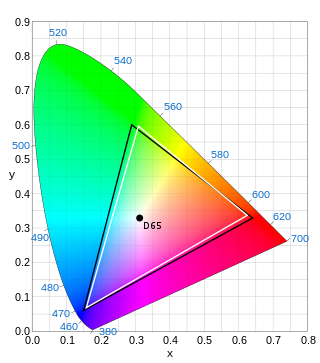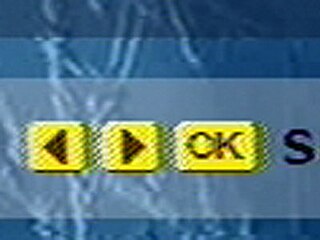Related Research Articles

Analog television is the original television technology that uses analog signals to transmit video and audio. In an analog television broadcast, the brightness, colors and sound are represented by amplitude, phase and frequency of an analog signal.

TiVo Corporation, formerly known as the Rovi Corporation and Macrovision Solutions Corporation, was an American technology company. Headquartered in San Jose, California, the company is primarily involved in licensing its intellectual property within the consumer electronics industry, including digital rights management, electronic program guide software, and metadata. The company holds over 6,000 pending and registered patents. The company also provides analytics and recommendation platforms for the video industry.

The first American standard for analog television broadcast was developed by the National Television System Committee (NTSC) in 1941. In 1961, it was assigned the designation System M.

Video is an electronic medium for the recording, copying, playback, broadcasting, and display of moving visual media. Video was first developed for mechanical television systems, which were quickly replaced by cathode-ray tube (CRT) systems which, in turn, were replaced by flat panel displays of several types.

Digital audio is a representation of sound recorded in, or converted into, digital form. In digital audio, the sound wave of the audio signal is typically encoded as numerical samples in a continuous sequence. For example, in CD audio, samples are taken 44,100 times per second, each with 16-bit sample depth. Digital audio is also the name for the entire technology of sound recording and reproduction using audio signals that have been encoded in digital form. Following significant advances in digital audio technology during the 1970s and 1980s, it gradually replaced analog audio technology in many areas of audio engineering, record production and telecommunications in the 1990s and 2000s.

Digital Visual Interface (DVI) is a video display interface developed by the Digital Display Working Group (DDWG). The digital interface is used to connect a video source, such as a video display controller, to a display device, such as a computer monitor. It was developed with the intention of creating an industry standard for the transfer of uncompressed digital video content.

Composite video is an analog video signal format that carries standard-definition video as a single channel. Video information is encoded on one channel, unlike the higher-quality S-Video and the even higher-quality component video. In all of these video formats, audio is carried on a separate connection.

ITU-R Recommendation BT.601, more commonly known by the abbreviations Rec. 601 or BT.601 is a standard originally issued in 1982 by the CCIR for encoding interlaced analog video signals in digital video form. It includes methods of encoding 525-line 60 Hz and 625-line 50 Hz signals, both with an active region covering 720 luminance samples and 360 chrominance samples per line. The color encoding system is known as YCbCr 4:2:2.
A subcarrier is a sideband of a radio frequency carrier wave, which is modulated to send additional information. Examples include the provision of colour in a black and white television system or the provision of stereo in a monophonic radio broadcast. There is no physical difference between a carrier and a subcarrier; the "sub" implies that it has been derived from a carrier, which has been amplitude modulated by a steady signal and has a constant frequency relation to it.

Component video is an analog video signal that has been split into two or more component channels. In popular use, it refers to a type of component analog video (CAV) information that is transmitted or stored as three separate signals. Component video can be contrasted with composite video in which all the video information is combined into a single signal that is used in analog television. Like composite, component cables do not carry audio and are often paired with audio cables.

Serial digital interface (SDI) is a family of digital video interfaces first standardized by SMPTE in 1989. For example, ITU-R BT.656 and SMPTE 259M define digital video interfaces used for broadcast-grade video. A related standard, known as high-definition serial digital interface (HD-SDI), is standardized in SMPTE 292M; this provides a nominal data rate of 1.485 Gbit/s.
Broadcasttelevision systems are the encoding or formatting systems for the transmission and reception of terrestrial television signals.
High-bandwidth Digital Content Protection (HDCP) is a form of digital copy protection developed by Intel Corporation to prevent copying of digital audio and video content as it travels across connections. Types of connections include DisplayPort (DP), Digital Visual Interface (DVI), and High-Definition Multimedia Interface (HDMI), as well as less popular or now deprecated protocols like Gigabit Video Interface (GVIF) and Unified Display Interface (UDI).

Dot crawl is a visual defect of color analog video standards when signals are transmitted as composite video, as in terrestrial broadcast television. It consists of moving checkerboard patterns which appear along horizontal color transitions. It results from intermodulation or crosstalk between chrominance and luminance components of the signal, which are imperfectly multiplexed in the frequency domain. The term is more associated with the NTSC analog color TV system, but is also present in PAL. Although the interference patterns are slightly different depending on the system used, they have the same cause and the same general principles apply.
Copy Generation Management System – Analog (CGMS-A) is a copy protection mechanism for analog television signals. It consists of a waveform inserted into the non-picture vertical blanking interval (VBI) of an analogue video signal. If a compatible recording device detects this waveform, it may block or restrict recording of the video content.
MUSE, commercially known as Hi-Vision was a Japanese analog high-definition television system, with design efforts going back to 1979.

B-MAC is a form of analog video encoding, specifically a type of Multiplexed Analogue Components (MAC) encoding. MAC encoding was designed in the mid 80s for use with Direct Broadcast Satellite systems. Other analog video encoding systems include NTSC, PAL and SECAM. Unlike the FDM method used in those, MAC encoding uses a TDM method. B-MAC was a proprietary MAC encoding used by Scientific-Atlanta for encrypting broadcast video services; the full name was "Multiple Analogue Component, Type B".

A modulator-demodulator or modem is a computer hardware device that converts data from a digital format into a format suitable for an analog transmission medium such as telephone or radio. A modem transmits data by modulating one or more carrier wave signals to encode digital information, while the receiver demodulates the signal to recreate the original digital information. The goal is to produce a signal that can be transmitted easily and decoded reliably. Modems can be used with almost any means of transmitting analog signals, from light-emitting diodes to radio.
Pulse-code modulation (PCM) is a method used to digitally represent sampled analog signals. It is the standard form of digital audio in computers, compact discs, digital telephony and other digital audio applications. In a PCM stream, the amplitude of the analog signal is sampled at uniform intervals, and each sample is quantized to the nearest value within a range of digital steps.
This glossary defines terms that are used in the document "Defining Video Quality Requirements: A Guide for Public Safety", developed by the Video Quality in Public Safety (VQIPS) Working Group. It contains terminology and explanations of concepts relevant to the video industry. The purpose of the glossary is to inform the reader of commonly used vocabulary terms in the video domain. This glossary was compiled from various industry sources.
References
- ↑ "Hi-tech TV Tracking". PSA Research Center. Goodwill Communications. Archived from the original on March 27, 2006. Retrieved December 23, 2005.
- ↑ "Warner Bros. Consumer Products, Mattel and VEIL Technology Announce First-ever Truly Interactive Television Toy Line". VEILInteractive.com. VEIL Interactive Technologies. Archived from the original on December 23, 2005. Retrieved December 23, 2005.
- ↑ Hachman, Mark (November 2, 2005). "How Will Veil's Technology Plug the Analog Hole?". ExtremeDRM.com. Ziff Davis. Archived from the original on April 27, 2006. Retrieved December 23, 2005.